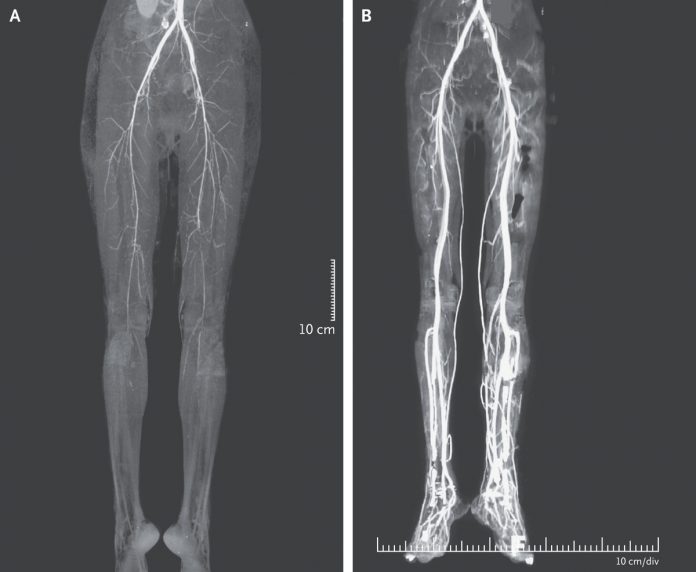A 24-year-old woman with a history of congenital HIV infection presented to the clinic with complaints of pain in her legs for the past 2 days. The patient describes her pain as burning in nature and quite severe. The pain involved the legs from the toes to the mid-thigh. She also complained of difficulty in walking and discoloration of the legs.
The usual medication that she took for HIV included tenofovir, emtricitabine, and lopinavir-ritonavir, but 4 days before the presentation, she had started taking ergotamine two times in a day for migraine.
On physical examination of the legs, the legs were cold, with nonpalpable popliteal and dorsalis pedis pulses bilaterally.
Computed tomographic (CT) angiography was performed, which showed symmetrical and diffuse luminal narrowing of the arteries below the external iliac artery in both legs (Panel A).
Ergotism was suspected owing to the patient’s history of starting ergotamine for migraines along with the daily use of ritonavir as the latter inhibits the enzyme CYP3A4, which leads to increased serum levels of ergotamine. This drug-drug interaction was found to be responsible for the vasospastic limb ischemia.
Intravenous prostaglandin and unfractionated heparin were initiated, which improve the patient clinically. The legs started revascularizing; therefore, they became warmer, and the pain alleviated. The second toe of the left foot had become gangrenous, so it was amputated.
After two weeks, a repeat CT angiogram was done, which revealed improved perfusion in both legs (Panel B).
Ergotism can be caused by a fungus or by drugs with ergotamine and its compounds. Ergot alkaloid and its derivatives cause vasoconstriction. The patient in the discussion here was taking a drug that inhibited the hepatic metabolism of ergotamine—this accumulated ergot alkaloids in the body leading to vasoconstriction of the vessels in the legs. Vasospasm also increases the risk of thrombosis, irreversible ischemia, and gangrene, as seen in this patient.
But ergotism is reversible.
Early diagnosis and prompt are required to avoid gangrene and irreversible ischemia!
References:
Aravind Reghukumar, M. a. (2020, July 23). Burning Pain in the Legs. Retrieved from The New England Journal of Medicine: https://www.nejm.org/doi/full/10.1056/NEJMicm1911089
Liegl CA, McGrath MA. Ergotism: Case Report and Review of the Literature. Int J Angiol. 2016;25(5):e8-e11. DOI:10.1055/s-0034-1376397




